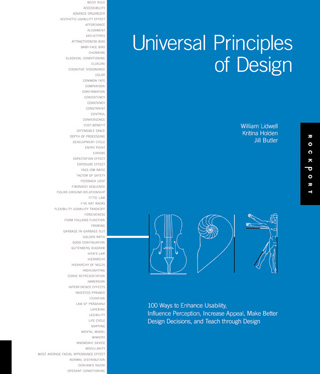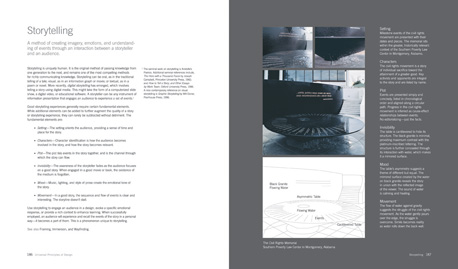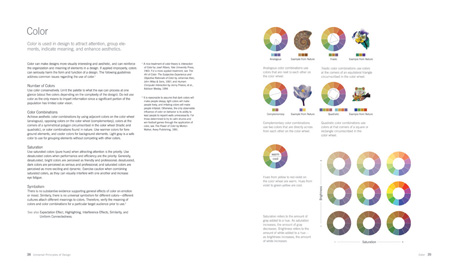Universal Principles of Design
Reviewed by Rob Tannen.
Although Universal Principles of Design
From its academic textbook-style cover, one might overlook this book or assume that its content would be dull and dry. In fact, it is an academic design book but in the most positive sense of the word. Design is treated as a holistic discipline with global principles, rather than limited to a particular sub-practice, such as graphic or industrial design.
The authors, William Lidwell, Kritina Holden and Jill Butler from Stuff Creators, summarize a diverse range of 100 design principles from sources including human computer interaction, aviation, biology, mathematics, and gestalt psychology, to name a few. The topics range from quantitative (e.g. Golden Ratio, Fitt’s Law, Normal Distribution) to qualitative (e.g. Consistency, Framing, Similarity), but are all applicable to various design applications.
For example, the principle of Forgiveness (avoidance and support for errors) includes these recommendations:
Create forgiving designs by using good affordances, reversibility of actions, and safety nets. If this is not possible, be sure to include confirmations, warnings, and a good help system. Be aware that the amount of help necessary to successfully interact with a design is inversely proportional to the quality of design – if a lot of help is required, the design is poor.
Note that even in this excerpt, the style is relatively succinct – this is not a how-to book by any means and assumes that the reader has the knowledge (or access to it) to realize the recommendations in practice. But the book cites references for further reading on many of the principles and, more importantly, provides compelling and diverse examples to illustrate each principle. Demonstrations of the forgiveness principle include software, road signs, and mechanical devices, for example.
This type of diversity and balance from across human experiences is rare in a book – most tend to focus on a particular area, such as just software. I found myself learning new things as well as affirming my existing knowledge from my own education and experiences.
The combination of content and illustrated examples work very well together and the book’s format is one of its greatest strengths: two-page spreads on each of 100 principles, sequenced alphabetically. The left page provides the descriptive information, guidelines and references, the right side provides illustrations of representative case studies. In the spread below on the topic of Color, color combinations are illustrated with associated examples from nature to clarify color theory:
The book’s accessible structure can serve as a reference on particular topics as needed, or it can be read straight through as a primer on design thinking. Indeed, when I first bought Universal Principles of Design I read it cover-to-cover and since then have referred to it innumerable times for a description, reference or an example.
In fact, the book is intended for a range of uses as its subtitle explains: “100 ways to enhance usability, influence perception, increase appeal, make better design decisions and teach through design”. I will add one more – improve your design vocabulary. Terms such as “aesthetic-usability effect” and “cost benefit analysis” have now become part of my everyday design language, whereas before I used less direct terms to discuss these key principles.
If there is a criticism of this book it may be in the choice of the 100 principles. The authors admit that there are far more than 100, but they had to compromise for practical reasons. Given that, I wonder why certain oddities made it in, like the “Baby-Face Bias” (characteristics assigned to certain facial characteristics).
On the other hand, it is the diversity of principles that make Universal Principles of Design
For some second-opinions, you can read reviews by Don Norman and the SAP Design Guild but don’t expect to find anything critical.
Buy Universal Principles of Design from Amazon.com


Postscript
A new version of Universal Principles of Design is in the works for Fall of 2009, which will include updates to the existing 100 principles based on new research and examples, as well as twenty-five new principles.
Lidwell is also in the process of writing a different book, Deconstructing Product Design, which will provide expert design and usability reviews of a range of consumer products from the last 100 years. He is asking design professionals and enthusiasts to contribute their input. The 100 classic products that will be covered in the book – from the Sony Walkman to Cabbage Patch Dolls – are presented on the Deconstructing Product Design web site. You can provide your comments about any of these individual products until Dec 15th and they may end up included in the published book.
About the reviewer
Rob Tannen is a human-centered design researcher with expertise in both product and software user interfaces. He is Director of Research at Bresslergroup, a leading product development firm, and is also a professional writer/presenter on topics ranging from simplicity in design to effective research methods. He created Designing for Humans, a reference blog for designers and researchers.




